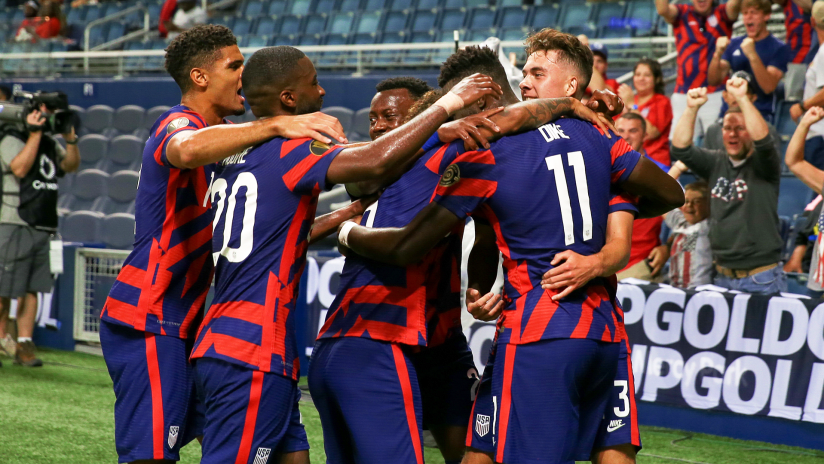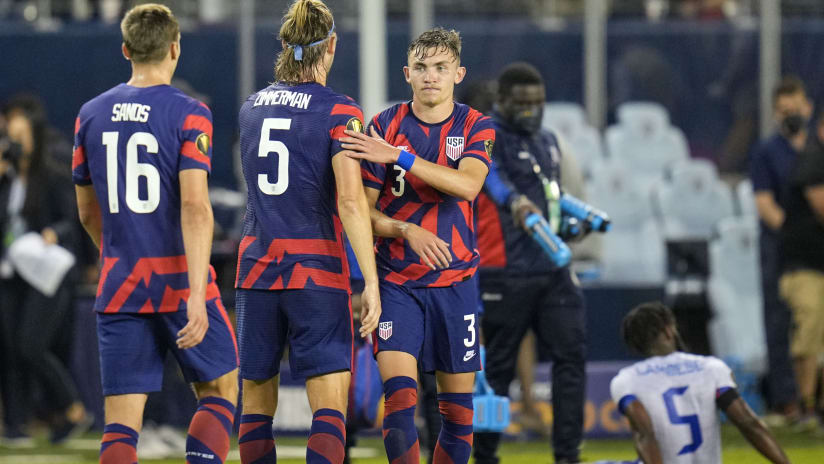The US men’s national team are officially through to the Concacaf Gold Cup knockout phases after tagging a hexagonal (RIP) on Martinique Thursday night at Children’s Mercy Park in KC.
That’s a bare-minimum box to check for the Yanks at this tournament, of course, and the showpiece occasion of the Group B slate, a meaningful clash with Canada, now awaits on Sunday evening at the same venue. Here’s the breakdown.
Daryl wants that No. 9 spot
By now you’ve seen the highlights. Daryl Dike isn’t climbing the power rankings, he IS the power rankings.
Yes, allowances must be made for the limited opposition provided by a side representing a small French overseas department. That applies in all such scenarios like these, which are a perennial quirk of Concacaf life. And rough edges remain on the 21-year-old’s game: Cleaner technique would have bagged him a hat trick instead of allowing the USMNT’s second to turn out as a Samuel Camille own goal, for example.
But we shouldn’t dismiss Dike’s rugged, vibrant performance, a seizing of the moment to underline the seriousness of his candidacy for the top spot on Gregg Berhalter’s striker depth chart. There’s something tangibly, noticeably different about games in which the Oklahoma Ibra is on one – he emanates a gleeful sort of menace that seems to convey to his teammates as well.
Martinique's defensive anchor Jean-Sylvain Babin plays for Sporting de Gijón in the Spanish second division; he’s no farmer. He and his teammates were helpless against Dike’s movement, physicality and sheer force of personality, and I suspect other defenders around the region will be vulnerable to the same treatment in World Cup qualifying.
The 3-4-2-1 can work, and James Sands is key to it
Berhalter has grown comfortable with a couple of tactical riffs based on a three-player back line. Though some of us initially expected a 3-5-2, Thursday’s XI was different from the 5-3-2 look the USMNT shifted into to hold off Haiti in the second half of their opener. As the Big Brain in the Comfy Seat himself noted:
I think this shape works better with this squad than previous groups with which Berhalter has tinkered with it, and the pleasing patterns that the Yanks carved out in their best moments were entertaining proof of its value. But the whole thing asks a lot of the center backs, and tends to hinge on their characteristics – and dependability. And until relatively recently it was not a very common system in MLS and other places where most US defenders ply their trade.
Sands, on the other hand, has grown up in New York City FC’s cosmopolitan culture, where the likes of Patrick Vieira and Dome Torrent and Ronny Deila have helped mold him into a calm, clean, cerebral tempo-setter able to thrive as either a No. 6 or the central back in a line of three. His comfort and precision in passing out of the back is lovely to behold (Europe will be calling any day now) and it girded the USMNT buildouts against Les Matinino.
“I liked his game today. I thought it was excellent,” said Berhalter afterward. “He battled, he competed, his passing was excellent. So it gives us an option. You don’t always have the opportunity to play three in the back, but he gives you that option, certainly. So really proud of James, proud of the way he's performed in both of the games, and he's been fun to work with so far.”
He’s new to this level, but Sands’ traits are rare and valuable enough that I suspect he’ll rise quickly.
Some stakes for the next US-Canada grudge match
As overmatched as Martinique may have appeared for most of the run of play, in this funny old sport it can only take one fleeting slip to incur costly penalties – like, say, the PK Kellyn Acosta conceded just past the hour mark when he tugged on Kevin Fortune and gifted the underdogs a freebie.
While the USMNT cracked the whip on themselves to keep racking up goals until the very end (the urgency of Berhalter's urging was noteworthy), it turned out that goal is what prevented them from surpassing Canada in goal differential, and thus in the standings, ahead of their Group B finale. With both nations on +6, the second tiebreaker of goals scored now applies, and Les Rouges are a nose ahead there.
“Canada had played right before us. So we knew the situation we were in and it was unfortunate that we couldn't get the last goal,” said Cristian Roldan postgame. “We had subs come in and re-emphasize the goal situation. And we pushed, and unfortunately we didn't score that last one. But we're still in good position to get first in the group. And that's the goal that we're setting.”
So the US must win on Sunday in order to finish first in the group, which would drop them into the opposite side of the knockout bracket from where Mexico (and probably Honduras) are likely to land out of Group A. A draw will do for Canada to hold that spot, and their wily management of their earlier game vs. Haiti suggests they’re confident of keeping the USMNT to a point.
All that adds up to another spicy cross-border faceoff like the ones we enjoyed during the group stage of the Concacaf Nations League, where the two sides both held serve on home turf before the US advanced to the semifinals on superior goal differential. Will John Herdman & Co. turn the tables in KC? And to be fair, it’s also valid to ask whether any of it will really matter once the knockout stages are underway.
Whatever your perspective, Sunday figures to be a fun one.












